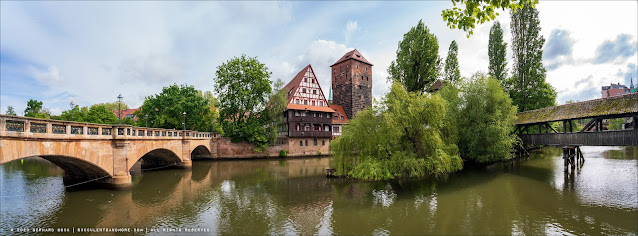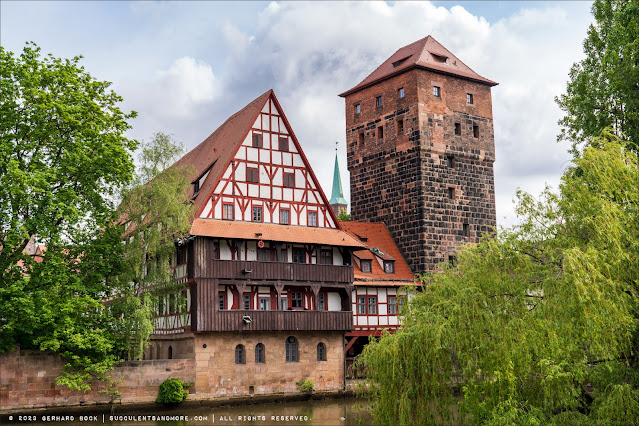Nürnberg, or Nuremberg in English, is the closest “big city” to my hometown of Hersbruck (see this post). Downtown Nuremberg is just 20 miles away, a 30-40-minute drive depending on traffic. The smarter choice is to hop on a train, which takes just 15 minutes. And unlike elsewhere (here’s looking at you, Amtrak), trains are plentiful and generally on time.
 |
| Along the River Pegnitz |
Nuremberg has a rich history that stretches back over a thousand years. The city’s story began in the Middle Ages when it emerged as a major center of trade and commerce in the Holy Roman Empire.
In the 11th century, Nuremberg became an imperial city, granting it a considerable degree of autonomy and self-governance. The city flourished as a hub for manufacturing and craftsmanship, particularly in metalworking, textiles, and printing. It also became renowned for its annual trade fairs, attracting merchants from across Europe.
During the Renaissance, Nuremberg was home to artists such as Albrecht Dürer, a prominent painter and printmaker. Dürer’s works made a significant impact on German art and contributed to Nuremberg’s reputation as a center of artistic excellence.
 |
| Several historic foot bridges cross the River Pegnitz |
In the 16th century, Nuremberg played a crucial role in the Protestant Reformation. The city embraced the teachings of Martin Luther, and its citizens converted to Protestantism, leading to tensions with the Catholic Church. Nuremberg became a stronghold for the Protestant movement, hosting religious debates and attracting notable reformers.
Nuremberg’s history took a dark turn during the 20th century. It became a prominent site for Nazi propaganda and a symbol of the Nazi Party’s power. Adolf Hitler chose Nuremberg as the location for the annual Nazi Party Rallies, where massive displays of military might and propaganda took place. The infamous Nuremberg Laws, which stripped German Jews of their rights and led to widespread persecution, were announced in the city in 1935.
After World War II, Nuremberg gained international attention as the site of the Nuremberg Trials, held by the Allies in 1945-1946 to bring Nazi war criminals to justice. The trials marked a significant milestone in the development of international law and human rights.
In the post-war era, Nuremberg underwent extensive reconstruction and revitalization efforts. The city transformed into a vibrant industrial and economic center, particularly in sectors such as electronics and engineering. Nuremberg also became known for its numerous cultural and historical attractions, including the reconstructed medieval old town which had sustained significant damage during WWII, the Imperial Castle, and the Nuremberg Toy Museum.
Today, Nuremberg is a thriving city of 520,000 that serves as the region’s economic and cultural center. A major rail hub and an international airport connect it to the rest of Germany and to Europe at large.
 |
| Weinstadel, a former wine warehouse, and Henkerturm (Hangman’s Tower), part of the medieval city wall |
 |
| Henkersteg (Hangman’s Bridge) terminating at the Henkerturm (Hangman’s Tower) on the right. The city’s hangman lived in the tower from the 16th to the 19th century. |
 |
| Half-timbered houses... |
 |
| ...in a variety of colors |
| ↴ (In)famous hare sculpture by Jürgen Goertz, described thusly by Atlas Obscura: “A sculpture of a gigantic goggle-eyed hare is portrayed as having fallen hard upon and smashed open a wooden box from which spills a horde of numerous tiny and demonic-looking rabbits. Look closely and you will see that crushed beneath this heavyweight hare lies a person, whose lifeless hand can be seen outstretched from beneath the animal’s colossal bulk.” |
 |
This sculpture has been called one of the world’s ugliest pieces of art. I love it.
|
↴ The next set of photos were taken at or near the Imperial Castle, Nuremberg’s most prominent landmark. Located on a sandstone ridge above the city center, this group of fortified buildings dates back to the High Middle Ages and represented the power of the
Holy Roman Empire and Nuremberg’s significance within it.
 |
| Blooming lilac everywhere... |
 |
| ...even in the Imperial Castle |
 |
| View from the Imperial Castle |
 |
| Luginsland Tower |
↴ Walking down Castle Hill towards the city center:
 |
| St. Sebaldus Church |
 |
| The Hauptmarkt is the best place to buy regional produce. In December, it’s the site of the world-famous Nuremberg Christmas Market, the Christkindlesmarkt. |
 |
| Built between 1352 and 1362, the Frauenkirche (Church of our Lady in English) is a stunning example of Gothic architecture |
 |
| Frauenkirche |
 |
| Mobile planters... |
 |
| ...add a welcome touch of green... |
 |
| ...to the cobble-stoned square |
 |
| White asparagus and strawberries |
 |
| Germans love their white asparagus. Personally, I much prefer the green variety. |
 |
| Fresh strawberries grown right outside of Nuremberg |
↴ The pedestrian zone in the center of Nuremberg is one of the largest of its kind in Europe. It’s truly wonderful being able to explore without having to worry about vehicle traffic.
 |
| Built in 1339, the Heilig-Geist-Spital was the largest hospital in the imperial city. Today, it’s a retirement home. |
↴ The man-crushing hare I showed you earlier isn’t the only piece of public art in Nuremberg that people love to hate. Probably the most beloved and behated example is the
Ehekarusell, or Marriage Merry-Go-Round. Installed in the early 1980s, it’s based on the poem “
Das bittersüße ehlich’ Leben” (“Bitter-Sweet Married Life”) by 16th-century Nuremberg poet
Hans Sachs and vividly depicts the various phases of marriage—from courtship and passion to strife and death. I love it and make a point of visiting it every time I’m in Nuremberg.

I’m back home now and have a lot of catching up to do...
© Gerhard Bock, 2023. All rights reserved. To receive all new posts by email, please subscribe here.





































A beautiful city. Thanks for sharing your visit, Gerhand. Although I'm sure a city that old with that much history provides an endless source of photographs, I'm impressed by the breadth of your coverage. You even caught a couple having what I assume were wedding photos in #20! I hope you had a good visit with your family.
ReplyDeleteA Protea, that was a surprise. Wonder if someone will try to grow it as a houseplant--it might be possible.
ReplyDeleteThanks for the tour of a historic city. Were the strawberries tasty?
Seeing the Heilig-Geist-Spital I now realize I have been touring in Nuremberg, but it is strange I do not remember the Ehekarusell! Can you imagine those blankets or even the mobile planters in the U.S. I hate to say it but the blankets would be gone in no time and the planters would be vandalized. I love the half-timbered houses so much. They remind me of Grimm fairy tales!
ReplyDeleteA beautiful city, the Frauenkirche is a marvel. I just listened to a wonderful Podcast 'Criminal', an interview with Benjamin Ferencz, prosecutor from the Nuremberg trials from 2018. They replayed it after his recent death at age 103. It's a wonderful episode. I love the public art, at first I saw a large fish not a rabbit. Marriage merry go round doesn't look particularly like a happy one, haha.
ReplyDeleteGreat photos and information! One of these days we must get to Germany and Switzerland (and other European destinations). The gardens and planters and farmers' market are quite impressive. Thanks for sharing!
ReplyDeleteNuremberg looks like a lovely small city. Love the red roofs on all the buildings. Not sure about the statuary though. European's certainly know how to do things right.
ReplyDeleteI'd love to visit Germany someday. Thanks for sharing Nuremberg. Frauenkirche is spectacular. Love the color on the half-timbered houses too.
ReplyDelete